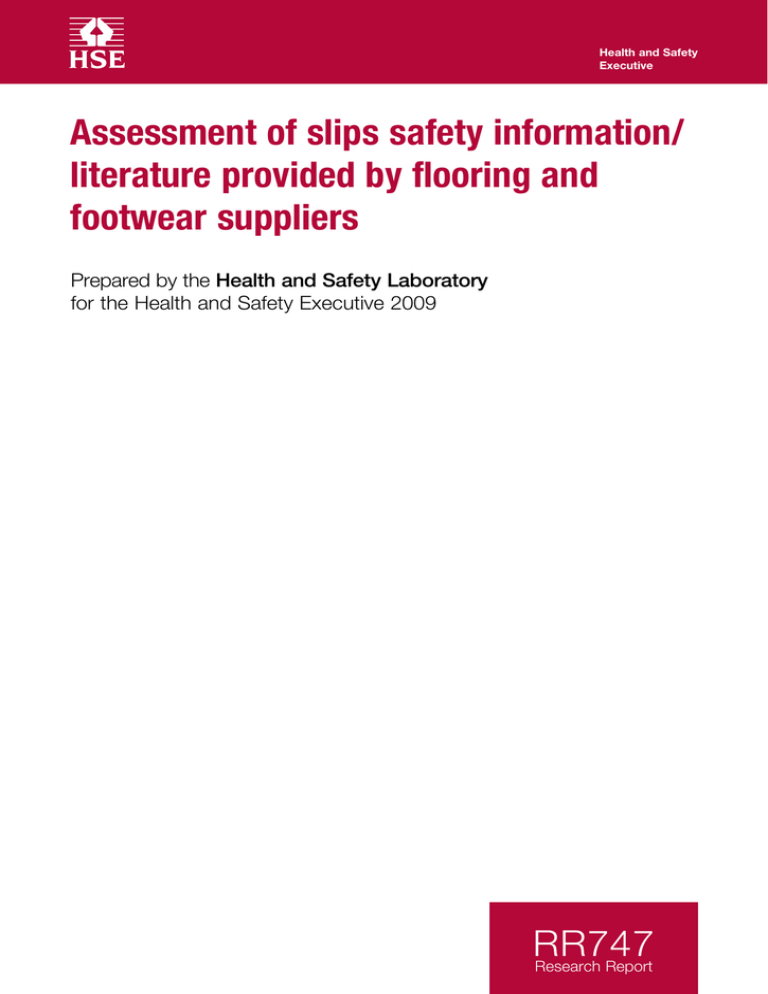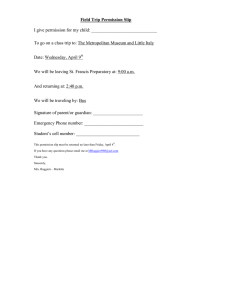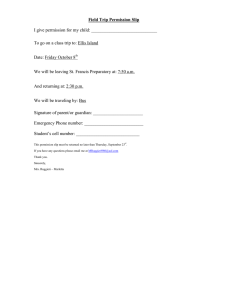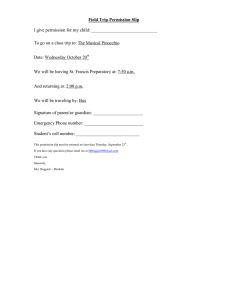
Health and Safety
Executive
Assessment of slips safety information/
literature provided by flooring and
footwear suppliers
Prepared by the Health and Safety Laboratory
for the Health and Safety Executive 2009
RR747
Research Report
Health and Safety
Executive
Assessment of slips safety information/
literature provided by flooring and
footwear suppliers
Mr Mark Liddle
Health and Safety Laboratory
Harpur Hill
Buxton
Derbyshire
SK17 9JN
Nearly 11,000 workers suffered serious injury as a result of a slip or trip in 2007. A key element of HSE’s
work to reduce slips and trips is to raise awareness of how slip risks can be controlled through the use of
suitable flooring and footwear.
Footwear suppliers use a variety of terms to describe their products, eg ‘slip-resistant’, ‘anti-slip’,
‘improving grip performance’ etc, and these can often mislead customers. Slip-resistant industrial footwear
will normally have been tested according to European standards, but many manufacturers and suppliers
do not give helpful additional information, such as the degree of slip resistance and the types of work
environment for which their products are most suited.
For flooring, it is currently very difficult to make comparisons between products due to the number of tests
used and specifications quoted. Where test data is provided, often very little explanation is given and the
lay person could be easily confused or misled.
HSE maintains that employers must be provided with clear and helpful information that will enable them to
source footwear and flooring products which are suitable for their work environment.
This report and the work it describes were funded by the Health and Safety Executive (HSE). Its contents,
including any opinions and/or conclusions expressed, are those of the authors alone and do not necessarily
reflect HSE policy.
HSE Books
© Crown copyright 2009
First published 2009
All rights reserved. No part of this publication may be reproduced, stored in a retrieval system, or transmitted in any form or by any means (electronic, mechanical, photocopying, recording or otherwise) without the prior written permission of the copyright owner.
Applications for reproduction should be made in writing to:
Licensing Division, Her Majesty’s Stationery Office,
St Clements House, 2-16 Colegate, Norwich NR3 1BQ
or by e-mail to hmsolicensing@cabinet-office.x.gsi.gov.uk
ii
CONTENTS
EXECUTIVE SUMMARY ................................................................................... V
1
INTRODUCTION..........................................................................................1
2 RESULTS AND DISCUSSION ....................................................................2
2.1
Footwear information................................................................................2
2.2
Flooring information..................................................................................4
3
CONCLUSIONS...........................................................................................8
4
FURTHER WORK........................................................................................9
5
APPENDIX.................................................................................................10
6
REFERENCES AND FURTHER READING ..............................................12
iii
iv
EXECUTIVE SUMMARY
Objectives
The aim of this project was to collect and assess the slips safety information/literature provided
by flooring and footwear suppliers, to enable HSE to ascertain whether or not flooring and
footwear suppliers are fulfilling their statutory duties, and to provide HSE with the opportunity
to assess the impact of subsequent interventions in the field.
A baseline assessment of the workplace flooring and footwear products available in the market
place in late 2008 was undertaken to:
• Determine the proportion of suppliers and manufacturers who supply slip resistance
data for their products.
• Determine the range of test methods that are being used to generate slip resistance data
and assess the validity of the test data provided.
• Compare slip resistance data held and/or generated by HSL with data provided by
manufacturers and suppliers to give an indication of the quality of the slip resistance
data being supplied.
Main Findings
A review of promotional and technical literature provided by footwear and flooring
manufacturers showed that improvements to the information could be made to help procurers
select a product that will work well in their work environment.
A significant proportion of flooring products (55%) did not make any reference to slip
resistance or provide any test data. However, the majority (88%) of those that claimed to be slip
resistant did have test data to support these claims. A significant proportion (16%) of flooring
data provided by suppliers did not consist of numerical test data but rather the German DIN ‘R’
and ‘A/B/C’ classifications; these have very broad acceptance criteria and so may not give a
precise indication of slip resistance. Furthermore, 13% of data provided by flooring
manufacturers was generated using other tests which, in the opinion of HSE, can provide
misleading results in contaminated conditions.
No indication of slip resistance was given for 47% of footwear products. Another 36% claimed
to be slip resistant but did not provide any test data to substantiate the claims. Others claimed
compliance with standard specifications rather than giving numerical data, which does not give
a clear indication of the product’s slip resistance. Furthermore, some of the standards that were
quoted were no longer current and had been superseded some years earlier.
It was noted that very few footwear or flooring suppliers offered advice on the suitability (or
otherwise) of their products for various environments. Where advice was given, it was
generally to recommend a product for a particular environment, seemingly without any evidence
to do so, without stating the environments where the product was not suitable. Where
limitations of use were stipulated, they tended to be based on product durability rather than slip
resistance, e.g. some floor manufacturers claimed products were not suitable for wet or outdoor
environments on the basis that water would spoil the product rather than because it would
become slippery when wet.
v
Unfortunately, due to the varied range of test methods used and, in many cases, the obscure data
provided, e.g. the German DIN ‘R’ classifications, it was very difficult to draw direct
comparisons with HSL test results. However, it was noted that some footwear products, whose
suppliers claimed that they were slip resistant without providing substantiation data, achieved
poor results when tested using HSL’s ramp test.
vi
1
INTRODUCTION
Nearly 11,000 workers suffered serious injury (RIDDOR reportable major injuries) as a result
of a slip or trip in 2007 and reducing this injury toll is a priority for the HSE. The Slips and
Trips programme is seeking to achieve a significant reduction in major accidents caused by slips
and trips. A key element of the Slips and Trips programme of work is to raise awareness of
slips and trips issues; this includes how slip risks can be controlled through the use of suitable
flooring and footwear.
Footwear can play an important part in preventing slips and trips but selecting the most suitable
slip resistant footwear for a particular environment and/or work activity can be very difficult.
Footwear suppliers use a variety of terms to describe their products, e.g. ‘slip resistant’, ‘antislip’, ‘improving grip performance’ etc. which can often mislead customers. Slip resistant
industrial footwear will normally have been tested for slip resistance according to BS EN
13287:2004 (amended in 2007). However, work carried out by HSL in 2006 to evaluate current
test methods used to measure slip resistance, has shown that this test has a lenient pass
threshold, raising concerns that this could give a false impression of the suitability of a product.
Many manufacturers and suppliers do not give additional information, such as the types of work
environment for which their products are most suited (or not suited) although they do have a
legal duty to provide accurate descriptions of their products to enable purchasers to understand
the relevant safety features, e.g. slip resistance data. If the number of slip and trip accidents in
workplace areas is to be reduced, then employers seeking to procure new flooring and footwear
must be supplied with clear and helpful information that will enable them to source products
which are suitable for their work environment.
Marketing and technical information for a wide range of flooring and footwear was collected to
assess the quality of information provided by suppliers. Information sources included:
manufacturers’ websites, suppliers’ websites, catalogues, brochures, and trade shows. Suppliers
were also contacted to request information regarding the slip resistance of their products.
The information and materials collected were examined to:
• Determine the proportion of suppliers and manufacturers who supply slip resistance
data for their products.
• Determine the range of test methods that are being used to generate slip resistance data
and assess the validity of the test data provided.
• Compare slip resistance data held and/or generated by HSL with data provided by
manufacturers and suppliers to give an indication of the quality of the slip resistance
data being supplied.
1
2
2.1
RESULTS AND DISCUSSION
FOOTWEAR INFORMATION
In total, the literature pertaining to 1304 different styles and 55 different trade names of safety
footwear was evaluated. Of the 1304 styles surveyed, 685 (53%) claimed to be slip resistant.
Of this 53%, 183 (27%) claimed compliance with slip resistance specifications; 65 (9%) had test
data in support of these claims and a further 147 (21%) had data available on request. A
breakdown of the type of information provided for each style of footwear included in our survey
is shown in figure 1.
11%
Slip resistance not specified
5%
Slip resistant / no data available
47%
Slip resistant / data included in
catalogue or on website
36%
Slip resistant / data available on
request
Figure 1: Graphical summary of the slip resistance claims being made by suppliers, and the
information they provide about their footwear.
A review of the test data being quoted by suppliers showed that the majority of it was generated
using tests known to have a lenient pass threshold. Data generated by HSE’s preferred test (the
HSL ramp test, HSL-PS-SOP12), was quoted for 26 styles. In addition to these, HSL has been
employed to conduct ramp testing on other styles included in this study. However, where no
details have been published in the suppliers’ promotional literature or on websites, these have
not been included in our summation. A large proportion of suppliers did not provide test results
but did claim their products complied with various specifications. A breakdown of the various
specifications quoted by suppliers is shown in figure 2.
2
Test specification quoted
DIN4843 PART 100/EN
ISO20345:2004
3%
4%
\
13%
BS EN 13287
\
45%
PM144:1992
EN ISO 20347
34%
HSL RAMP
Figure 2: Graphical summary of the test specifications quoted by suppliers, where a test
specification was quoted. Issue date/version not always specified. See section 6 for a key to the tests.
It was noted that some suppliers were quoting compliance with BS EN ISO 20347:2004 in a
way that could suggest slip resistance testing had been carried out. However, this version of the
standard only makes reference to cleat design and does not specify any slip resistance
requirements. The types of tests that were used to assess slip resistance are shown in figure 3.
14%
SATRA (PM144:1992 &
DIN EN 13287)
40%
RAMP (DIN4843 PART
100)
HSL RAMP
47%
Figure 3: Graphical representation of the type of test used.
To assess the validity of the test data quoted, some footwear products were tested in our
laboratory using HSL’s routine test procedures. Previous test data was also reviewed.
3
Unfortunately, due to the limited amount of numerical data provided by suppliers, direct
comparisons could only be made on two products; the results generated for these products were
in agreement with those quoted by the supplier. For details of footwear test data generated by
HSL, refer to report PED/05/04 & PED/07/01 (Published as HSL/2007/33). See
http://www.hse.gov.uk/research/hsl_pdf/2007/hsl0733.pdf
2.2
FLOORING INFORMATION
In total, the literature from 67 suppliers of workplace flooring was evaluated. This pertained to
24 different types of flooring materials and 1003 different surfaces. A breakdown of the types
of surfaces for which information was assessed is shown in Figure 4. More detailed information
is provided in Table 1, Appendix A.
450
400
Cementitious
Man-made stone
350
Number of products
Natural stone
300
Pre-engineered wood
Natural wood
250
Resilient - miscellaneous
Resilient - rubber
200
Resilient - vinyl
Resilient - linoleum
150
Resin
100
Coatings
Other hard flooring
50
0
Floor categories
Figure 4: Graphical representation of floor types covered in this study.
Of the 1003 surfaces included in our survey, 269 (27% of total) claimed to be slip resistant. Of
this 27%, 237 (88%) provided test data in support of these claims. Test data was also provided
for 160 (16% of total) floor surfaces for which no slip resistance claims were made. Data was
available on request for a further 26 (3% of total) of these surfaces. A breakdown of the types
of information provided by suppliers and any claims they may have made is shown in figure 5.
4
1%
3% 3%
Claims t o be slip resist ant , but no
dat a available
16%
Slip resist ance not specified / no dat a
available
Slip resist ant / dat a included in
cat alogue or on websit e
55%
Dat a available but no slip resist ance
claims made
22%
Slip resist ant / dat a available on
request )
Slip resist ance not specified / data
available on request
Figure 5: Graphical representation of suppliers’ claims and the information they provide.
The flooring industry is quite diverse with a huge range of products available from a large
number of suppliers. Most suppliers tend to specialise in a small number of floor types. The
information provided and the claims made for each floor type are presented in figure 6, to give
an indication of how each sector of the flooring industry performs with respect to providing
information to their customers.
5
100%
90%
80%
Slip resistance not sp ecified / data available
on request
70%
Slip resistant / data available on request)
60%
Data available but no slip resistance claims
made
50%
Slip resistant / data included in catalogue or
on website
40%
Slip resistance not sp ecified / no data
available
30%
Claims to be slip resistant, but no data
available
20%
10%
Re
sin
O
Co
th
er
at
in
ha
gs
rd
flo
or
in
g
s to
N
ne
at
Pr
ur
eal
en
s to
gi
ne
ne
er
ed
Re
w
N
oo
sil
at
d
ie
u
ra
nt
-m lw
oo
isc
d
e
lla
Re
ne
sil
ou
ie
nt
s
-r
Re
u
bb
si
er
Re lien
tsil
v
ien
in
yl
tlin
ol
eu
m
e
ad
-m
an
M
Ce
m
en
tit
io
us
0%
Figure 6: Graphical representation of suppliers’ claims and the information they provide for each floor type.
6
A review of flooring test data showed that 54% was generated using the pendulum test, 33%
using the ramp test, 0.2% using roughness measurements and 12.8% was generated using sledtype test methods, which in the opinion of HSE, can provide misleading results in contaminated
conditions. Refer to HSE’s technical information sheet for assessing the slip resistance of
flooring, available from http://www.hse.gov.uk/pubns/web/slips01.pdf.
13%
Pendulum
54%
33%
Ramp
Other
Figure 7: Graphical representation of the type of test used.
A more detailed breakdown of the types of tests used is given in Table 2, Appendix A.
To assess the validity of the test data quoted, some floor surface samples were obtained and
tested in our laboratory using HSL’s routine test procedures, i.e. the HSL ramp and pendulum
tests. Previous test data was also reviewed. Unfortunately, due to the extensive range of test
methods quoted by suppliers, direct comparisons could only be made on three safety vinyl
surfaces; the results obtained for these surfaces were in agreement with those quoted by the
supplier.
7
3
CONCLUSIONS
The information provided by footwear and flooring manufacturers was not satisfactory. Many
footwear manufacturers made vague claims suggesting slip resistance and did not provide
supporting data. Many flooring manufacturers avoid making reference to slip resistance
altogether and information was hard to find.
Generally flooring suppliers were better than footwear suppliers at providing data to support
their claims regarding the slip resistance of their products. However, due to the broad range of
test methods used and, in many cases, the obscure data provided, e.g. the German DIN ‘R’
classifications, which have very broad acceptance criteria, it is very difficult to gain a clear
understanding of how well a floor surface will perform in a particular environment.
Relatively few footwear suppliers provided numerical data for their products, and instead
quoted compliance with various specifications. Many claimed their products were slip resistant
without providing substantiating data. When a selection of these products was tested using the
HSL Ramp Test, the results obtained suggested that several would have poor slip resistance in
some conditions (e.g. on a smooth wet steel surface).
It was noted that very few footwear or flooring suppliers offered advice on the suitability (or
otherwise) of their products for various environments. Where advice was given, it was
generally to recommend a product for a particular environment, seemingly without any evidence
to do so, rather than stating that a product was not suitable. Where limitations of use were
stipulated, it tended to be based on product durability rather than slip resistance, e.g. some floor
manufacturers claimed products were not suitable for wet or outdoor environments on the basis
that water would spoil the product rather than because it would become slippery when wet.
Unfortunately, due to the varied range of test methods used and the lack of numerical data, it
was very difficult to draw direct comparisons with HSL test results. Where comparisons could
be made, it was found that the values quoted by flooring manufacturers were in good agreement
with HSL results. However, it was noted that 12.8% of the data quoted by flooring suppliers
were generated using tests, which in the opinion of HSE, can provide misleading results in
contaminated conditions.
Recommendations
It was apparent that many suppliers did not consider slip resistance to be a selling point and did
not place significant emphasis on it. Currently, it is very difficult to make comparisons between
products due to the number of tests used and specifications quoted. Where test data is provided,
very little explanation is given and the layperson could be easily confused or misled.
Footwear and flooring suppliers should be influenced to place more emphasis on the slip
resistance of their products, and to use more standardised ways of assessing slip resistance; this
would allow customers to make comparisons and help them to select the most appropriate
product for their needs.
8
4
FURTHER WORK
Based on the findings of this project, a more targeted selection of footwear and flooring
products could be tested by HSL. By specifically selecting those products for which
comparable data is quoted, we could gain a clearer indication of the validity of data provided by
footwear and flooring suppliers.
After a suitable time period this study could be repeated to assess the influence of HSE’s Slips
and Trips programme on improving the information provided by industrial footwear and
flooring manufacturers.
9
5
APPENDIX
Table 1: Categorization of floor types
Floor type
Number of
Surfaces
Number of
Suppliers
Floor category
Cementitious
5
2
Concrete
2
2
Conglomerate tiles
10
2
Terrazzo
36
4
Stone
66
14
Natural stone
Laminate
61
7
Pre-engineered wood
Wood
102
20
Natural wood
Nitrile (rubber)
1
1
Resilient - miscellaneous
Polymer
1
1
Polyurethane
17
6
PVC (vinyl)
10
5
Luxury Non PVC tiles
1
1
Resilient flooring
1
1
Rubber
6
2
Resilient - rubber
Vinyl
152
17
Resilient - vinyl
Linoleum
33
4
Resilient - linoleum
Resin
51
9
Resin
Coatings
23
6
Coatings
Glass
5
1
Hard flooring
Metal
2
2
Ceramic tiles
62
9
Porcelain tiles
115
8
Quarry tile
9
2
Tile
232
9
10
Cementitious
Man made stone
Table2: Test specifications quoted by flooring suppliers
Data / Test type
Number of
Surfaces
Number of
Suppliers
Test category*
None
558
53
None
Class A/B/C (DIN 51097)
29
5
Ramp
R rating (DIN 51130)
93
7
RAPRA test
1
1
DIN51131
1
1
EN 13845
14
11
BGR 181
38
1
UNE-ENV 12633-2003
8
11
BS7044:1990
1
1
Pendulum
176
5
BS7976
47
4
BS6677
8
1
BS8204
2
1
BS2050
4
1
On request (Pendulum)
45
5
Surface roughness
1
1
Surface roughness
EN 13893
53
5
Sled test
ASTM C-1028
6
1
ASTM D2047
5
1
ADA
3
1
Tortus
5
1
Pendulum
The James machine
Tortus sled test
*For descriptions of test categories see ‘Assessing the slip resistance of flooring’
http://www.hse.gov.uk/pubns/web/slips01.pdf
11
6
REFERENCES AND FURTHER READING
M. Loo-Morrey, “Slip Testing of Occupational Footwear.” Report PED/05/04
M. Loo-Morrey & R. Houlihan, “Further Slip-Resistance Testing of Footwear for use at work.”
Report PED/07/01 (HSL/2007/33) http://www.hse.gov.uk/research/hsl_pdf/2007/hsl0733.pdf
HSE’s technical information sheet for assessing
http://www.hse.gov.uk/pubns/web/slips01.pdf
the
slip
resistance
of
flooring:
HSL-PS-SOP12. HSL Ramp Test standard operating procedure
BS EN ISO 20345:2004 (A1:2007). Personal protective equipment. Safety footwear
BS EN 13287:2007. Personal protective equipment. Footwear test method for slip resistance
BS EN ISO 20347:2004 (A1:2007). Personal protective equipment. Occupational footwear
TM144:2004. Friction (slip resistance) of footwear and flooring
12
13
Published by the Health and Safety Executive
10/09
Health and Safety
Executive
Assessment of slips safety information/
literature provided by flooring and
footwear suppliers
Nearly 11,000 workers suffered serious injury as
a result of a slip or trip in 2007. A key element of
HSE’s work to reduce slips and trips is to raise
awareness of how slip risks can be controlled
through the use of suitable flooring and footwear.
Footwear suppliers use a variety of terms to
describe their products, eg ‘slip-resistant’, ‘antislip’, ‘improving grip performance’ etc, and these
can often mislead customers. Slip-resistant
industrial footwear will normally have been tested
according to European standards, but many
manufacturers and suppliers do not give helpful
additional information, such as the degree of slip
resistance and the types of work environment for
which their products are most suited.
For flooring, it is currently very difficult to make
comparisons between products due to the number
of tests used and specifications quoted. Where
test data is provided, often very little explanation is
given and the lay person could be easily confused
or misled.
HSE maintains that employers must be provided
with clear and helpful information that will enable
them to source footwear and flooring products
which are suitable for their work environment.
This report and the work it describes were funded
by the Health and Safety Executive (HSE). Its
contents, including any opinions and/or conclusions
expressed, are those of the authors alone and do
not necessarily reflect HSE policy.
RR747
www.hse.gov.uk



